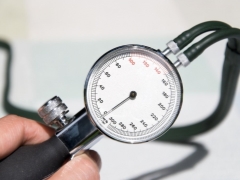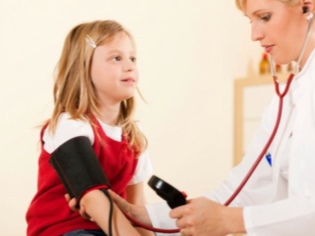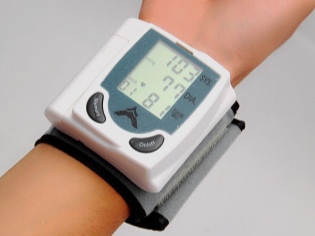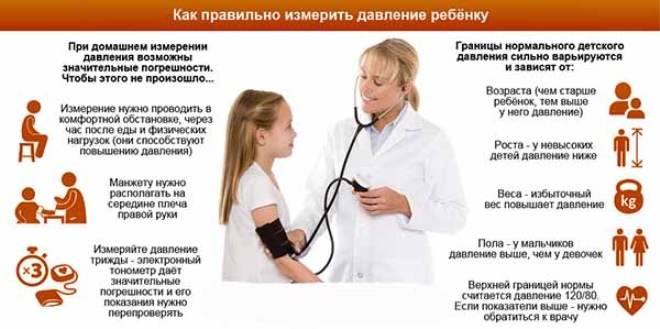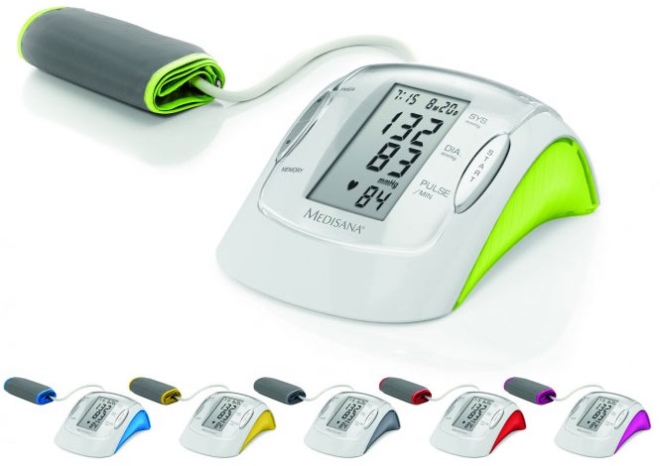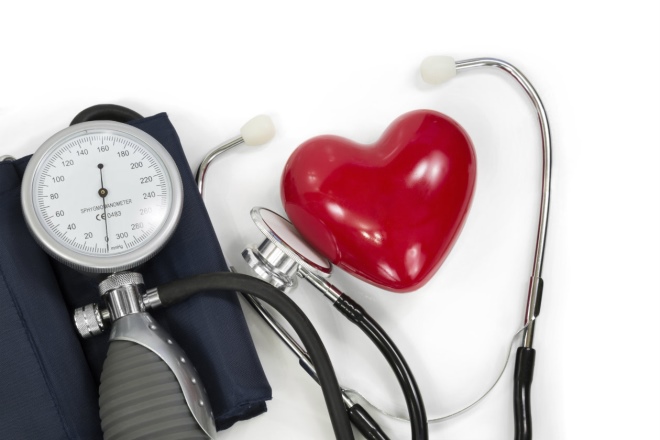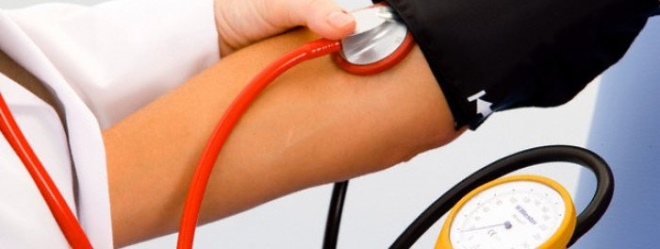Blood pressure norms in children by age, what to do in case of deviations
One of the indicators of the heart is the level of blood pressure. For each age has its own rules. The change in this indicator indicates a problem in the body and requires treatment.
What it is?
The heart pumps blood constantly. Such work provides uninterrupted intake of nutrients and oxygen to the internal organs. The blood, moving through the vessels causes their tension. This process is called arterial pressure (BP).
The diameter and size of blood vessels changes with age. This feature is associated with a decrease in plasticity and tone of the arteries and veins. These indicators affect the baseline blood pressure in different age groups. There are no marked differences in this parameter in children of the same age, boys and girls.
This indicator is quite stable and should not fluctuate strongly during the day. Any deviation from the norm requires attention and finding the cause that could have caused such a violation. Frequent fluctuations in blood pressure can lead to various diseases of the heart and blood vessels.
Measured in millimeters of mercury (mm. Mercury.). Usually, only two blood pressure indicators are analyzed - systolic and diastolic. In some cases, the pulse is also recorded.
Normal blood pressure indicators are summarized in various tables, which are designed taking into account mass surveys of babies of different ages. For their compilation, a large number of children of the same sex and age are examined. Such centile tables allow to determine the norms of this indicator in each specific age group. Arterial pressure on the brachial artery is measured.
During the day, this indicator of the work of the heart may vary. In hot weather, with intense physical exertion or after a strong psycho-emotional experience, the blood pressure figures may deviate significantly from the norm.
Kinds
To assess the performance of the heart, doctors use several indicators that can be calculated, knowing the initial level of blood pressure in a baby. Analysis of these parameters helps cardiologists determine the disease and even determine how hard heart or vascular disease can occur.
Why it is important to know the blood pressure of your child, you can learn from the following video.
There are several types of blood pressure:
-
Systolic. Shows the work of the heart during the period of active contraction. When listening to tones during a pressure measurement, it appears as the first sound that is heard in the stethoscope.
-
Diastolic. It characterizes the work of the heart during diastole - relaxation. When measuring pressure, it manifests as the last, clearly distinguishable sound.
-
Cordial. The arithmetic difference between systolic and diastolic pressure. In the aggregate of other indicators gives an idea of the work of the heart, as well as how well it pushes the blood through the vessels.
Algorithm and measurement technique
In order to determine the pressure in a child, you need to use a special device - a tonometer.Modern pharmaceutical industry offers a huge range of such measuring devices. They can be fully automatic or semi-automatic.
In order to measure the pressure in a child at home, use the following algorithm of actions:
-
Measure in the morning or before bedtime.
-
Starting position - sitting. The legs should be bent at the knees, feet about the same level. In newborns and infants, pressure is measured lying down.
-
Place a cuff 1-2 cm above the cubital fossa. A mother's finger should pass between the skin of the baby and the cuff. Do not try too tightly to put a cuff on your hand! A strong crush can cause a fright and pain in a child's measurement.
-
For an automatic device, simply press the power button. The instrument will start the measurement itself.
-
If the device is not automatic, then first place the phonendoscope in the region of the cubital fossa. The skin in this place is very thin, and here the pulse is perfectly audible. Pump the tonometer bulb until the pulsation stops.
-
Unscrew the valve on the pear and let the air out slowly. The appearance of the first well-audible sound - systolic pressure or upper. Listen to the pulsation to the complete disappearance of sounds. The last one is an indicator of diastolic pressure. It is also called the bottom.
-
Gently release all the air from the pear and remove the cuff from the baby's handle.
Blood pressure measurement is best done when the baby is calm. You can do this after waking up or before bedtime. To measure this figure immediately after a meal or active movements should not be. In this case, an elevated level of pressure will not be an accurate indicator of the heart’s normal operation.
Get a diary in which all indicators of blood pressure measurements in a child will be entered. Record systolic and diastolic pressure. If the tonometer is automatic and involves counting the pulse, then fix this indicator in the diary as well. Keeping such records will help the attending physician or cardiologist to evaluate the work of the heart and blood vessels more qualitatively.
For a more accurate result, it is better to measure blood pressure three times. Before each subsequent definition of the indicator, a 5-7 minute break is taken. The resulting values are summed and the average is calculated. Calculations are carried out separately for systolic and diastolic pressure. The arithmetic average is the most accurate indicator.
Is it possible to measure an adult tonometer?
For kids of different ages, there are their own baby cuffs. They are smaller in diameter and cling well to the child's handle.
Adult cuffs for measurements is not desirable. Usually they are too large for kids and do not allow to get a reliable result.
Measuring adult cuffs will only cause the baby a great pain, but will not be informative. For teenagers from the age of 14, teen cuffs are used. They can also be used in children of earlier age. If the child is too fat or has diabetes, the adolescent cuff can be used from 8 years.
The thickness of the inner chamber of the cuff in babies of the first days after birth should be three centimeters, and in children under one year old - five. During active movements or crying, a child may have increased pressure. It is better to measure the indicators during a complete calm.
Table by age
Blood pressure values change as your child grows. At preschool age, given the small diameter of the blood vessels and excellent elasticity, this figure is relatively lower than that of adolescents.
Blood pressure standards in children at different ages are presented in the following table:
|
Child's age |
Blood pressure (mm. Hg. Art.) |
|
|
Systolic (first sound in the stethoscope) |
Diastolic (the last sound in the stethoscope) |
|
|
Newborn |
60-96 |
40-50 |
|
Up to 1 year |
90-112 |
50-74 |
|
2 years - 3 years |
100-112 |
60-74 |
|
4 years - 5 years |
100-116 |
60-76 |
|
6 years old - 9 years old |
100-122 |
60-78 |
|
10 years - 12 years |
110-126 |
70-82 |
|
13 years old - 15 years old |
110-136 |
70-86 |
|
16 years |
115-140 |
75-90 |
These figures are approximate. Each identified single abnormality does not yet indicate the presence of a heart or vascular disease in the baby. To establish the diagnosis requires additional methods of examination, and not just blood pressure measurement.
In children from 7 years, there is some increase in pressure. This is due to the increasing mental burden in school. New environment and stress lead to an increase in the initial normal level of this indicator.
This condition can not be interpreted as a disease. Usually it passes after some time, after the child adapts to new conditions.
What causes a boost?
The reasons that lead to an increase in pressure are many. In every childhood they are their own. In some cases, the increased pressure may be the result of exposure to several provoking reasons simultaneously. This indicator changes not only in heart disease.
A persistent increase in blood pressure is called arterial hypertension.
The following reasons most often lead to the appearance of this condition in a child:
-
Damage to the renal vesselsleading to the development of secondary renal hypertension. May be congenital or acquired as a result of various kidney diseases. Usually cause an increase in systolic blood pressure. Difficult to treat.
-
Kidney disease. These include: traumatic injuries, cancer pathology, anatomical structure disorders, dysplasia. Cause mainly increase in diastolic pressure.
-
Heart diseases: defects in the structure of the valvular cardiac apparatus, congenital malformations, rhythm disturbances and myocardial conduction.
-
Endocrine pathologies. Crohn's disease or parathyroid tumors. As a result of these diseases, a metabolic disorder occurs. Biologically active substances and hormones begin to be produced in large quantities, which lead to a strong narrowing of blood vessels. This condition causes an increase in blood pressure.
-
Long-term use of pills and medicines. Hormonal drugs and sympathomimetics often lead to the development of arterial hypertension.
-
Bad habits. Adolescents who begin to smoke often suffer from arterial hypertension.
-
Rgenetic predisposition. In families where one of the parents has high blood pressure, the risk of having a child with arterial hypertension is 25%.
Increased pressure is not only in pathologies. In some cases, it rises after ordinary life situations. For example, severe stress or overwork in school can cause an increase in pressure. In boys from the age of 11, the level of blood pressure begins to exceed the corresponding indicators of girls-peers by 4-5 mm. Hg Art.
A child who plays sports or physical exertion irregularly also has a high risk of developing hypertension. Running too fast or intensely exercising can cause an increase in pressure in a child. This is due to the weak tone of the blood vessels.
Increased blood pressure may manifest itself in different ways. Usually the child feels a headache and weakness. Schoolchildren suffering from arterial hypertension, it is difficult enough to concentrate on the subject in school. After 2-3 lessons, he feels overwhelmed and unable to perceive the training material.
Another characteristic symptom of high blood pressure is dizziness or flickering flies before the eyes. This state does not last long. Usually dizziness goes away after a few minutes.With a persistent increase in blood pressure, it may not disappear within a couple of hours.
Very high pressure can even cause vomiting. Usually it is short and does not depend on food intake. This symptom is quite rare, but requires urgent treatment to a doctor. When vomiting occurs, not only high blood pressure should be suspected, but also increased intracranial.
What leads to a decrease?
Low blood pressure called arterial hypotension. This condition occurs in infants and toddlers at different ages. As the child grows, the level of pressure should increase. If this does not happen, then this is already a valid reason for going to a doctor.
The most common causes of hypotension are as follows:
Diseases of the thyroid gland. A reduced level of thyroid hormones causes a violation of vascular tone. This condition leads to the development of pressure reduction. Only treatment of the thyroid gland helps to normalize the condition.
Injuries and brain tumors. The circulatory center is in the cortex. When it is damaged, there is a lack of coordination in the work and tonus of the blood vessels. Such conditions can lead to the development of persistent pressure reduction.
Diseases of the endocrine system. Metabolic disorders lead to changes in the elasticity and tone of the arteries.
Anemia.
Exhaustion after severe and frequent respiratory infectious diseases.
Strong stress.
Malnutrition and inadequate nutrition.
Lowering blood pressure in a child is a reason to examine the baby more carefully. Many chronic diseases, which can be very dangerous, cause persistent hypotension. Normalization of pressure in such situations is possible only with the correct treatment of the underlying disease that caused this condition.
Hypotension is also not an independent disease. This is just a symptom occurring in various conditions. Even banal stress or severe overwork can cause a decrease in pressure in the baby.
Hypotension is also common in adolescence in girls who begin to replicate adult behavior. Excessive addiction to thinness and harmony can cause anorexia in a girl. This condition is often accompanied by a persistent decrease in blood pressure, which is difficult to normalize even taking medications.
Manifested a reduced pressure violation of general well-being. Usually the child becomes more sluggish. Schoolchildren cannot concentrate while studying. Children of earlier age begin to act up, become more sluggish and slowed down. With a marked decrease in blood pressure, a headache may occur.
How to lower the pressure?
Several methods are used to normalize blood pressure. In the presence of persistent hypertension, doctors prescribe a whole range of therapeutic methods. Such a system allows reducing pressure and keeping it at the proper level for many years.
To eliminate arterial hypertension apply:
-
The correct mode of the day. Morning rise at the same time helps to normalize the tone of blood vessels and normalize blood pressure.
-
Full sleep. At night, the baby must sleep at least 8-9 hours. Kids of preschool age should also rest in the afternoon. Usually, 2-3 hours are given for daytime sleep.
-
Good nutrition with a reduced amount of salt. It contains sodium. On admission in large quantities, it can cause severe spasm and constriction of the blood vessels. This leads to an increase in pressure. Limiting salt and all canned as well as pickled foods has a beneficial effect on blood pressure levels.
-
Medication. Diuretic, antispasmodic, ACE inhibitors, as well as calcium channel blockers can be used. The selection of the drug is based on the underlying disease, which caused an increase in pressure. For kidney disease, potassium preparations are used.
-
The optimal training regime. Loads in sports sections or when playing sports for a child with arterial hypertension should be strictly metered and not excessive. Do not overwork. This condition often leads to an increase in pressure.
-
Reducing stress and psycho-emotional stress. Neurotic conditions often lead to the development of hypertension in children. Large loads in school, with which the child does not cope well, also contribute to an increase in pressure.
-
Walks in the open air. A large amount of oxygen has a positive effect on the tone of the blood vessels and eliminates spasms. Walking at a moderate pace for at least an hour a day helps to normalize blood pressure.
-
Getting rid of bad habits. Smoking in adolescence and the use of low alcoholic alcoholic beverages contributes to the development of hypertension, and subsequently - even hypertension.
How to increase the pressure?
Before taking measures to increase blood pressure, you should show the child to a cardiologist. Often, the mask of arterial hypotension hides many diseases that require prior treatment. Without eliminating the cause, which caused a persistent decrease in pressure, it cannot be normalized.
To cope with the symptoms of hypotension, you can use the following methods:
-
Active exercise. When choosing them, one should give preference to the individual characteristics of the child and take into account his interests. For the normalization of blood pressure fit almost all types of physical activity. They should be performed regularly.
-
Full nutrition with age. Insufficient intake of all necessary elements and vitamins leads to a child’s lagging physical development, as well as to a decrease in the tone of blood vessels. The baby should eat at least 5-6 times a day.
-
Strengthening immunity. Frequent colds and infectious diseases lead to persistent hypotension. Regular walks in the fresh air and good nutrition will help the child to strengthen the immune system and less sick.
-
Strong tea or cocoa. For teens - coffee. With an attack of strong pressure reduction, these drinks should be offered to the child. They contain in their composition caffeine, which increases the pressure. If a child has an arrhythmia, then coffee is contraindicated.
-
The use of adaptogens. You can use Eleutherococcus, infusion of lemongrass or ginseng. The use of these medicines may cause an allergic reaction. Before use, you should show the child to the doctor to exclude possible contraindications.
-
Massage. Usually carried out in a stimulating mode. Helps to normalize vascular tone. Appointed by the course of 10-12 procedures 2 times a year.
-
Various physiotherapy techniques. Contrast shower or underwater massage are great. These methods normalize the work of the organs of the cardiovascular and nervous system. Usually, after 8-12 sessions, blood pressure is normalized.
-
Drugs based on caffeine. Discharged by a cardiologist. Do not apply to children suffering from cardiac arrhythmias. Such drugs can not be used for arrhythmias.
Who to contact?
If the measurement of blood pressure in a child revealed a deviation from the norm, then it should be shown to a pediatrician or cardiologist. Any changes to this important indicator may indicate problems in the work of the heart or internal organs.
Doctors may order additional tests for the examination.These include Hallter blood pressure measurement. With the help of a special apparatus, which is placed on the child, the control of the parameters of the heart is performed for a full day. This study allows you to more accurately establish the diagnosis and identify the cause of abnormalities in blood pressure.
Disorders of the heart can have very dangerous consequences. Control of blood pressure levels must be carried out in children at any age. This will allow to identify the first symptoms in time, and start treatment in time.
